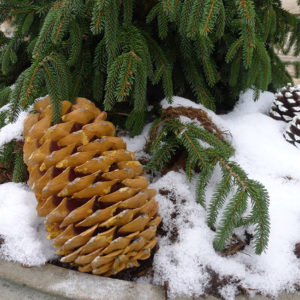 As beautiful as the winter landscape is, sometimes Mother Nature can use a helping hand. When I look out my windows as the days get shorter, I need to see something that lifts my spirits.
As beautiful as the winter landscape is, sometimes Mother Nature can use a helping hand. When I look out my windows as the days get shorter, I need to see something that lifts my spirits.
The best way I’ve found to add a touch of color and some good cheer to my empty garden is a few well-placed containers brimming with hardy plants, fresh evergreen boughs, pine cones and other natural materials. If there’s an electrical outlet nearby, a length of twinkly lights chases the gloom away.
It’s easy to change out pots filled with fall foliage to create a winter container garden. First, choose the pots that can stand up to cold temperatures, like fiberglass, iron, wood or heavy plastic. Store away the terra cotta clay containers because they can crack or flake from cold winter weather.
The next step is gathering the plants and other materials to design the winter container. Select one or more hardy plants that are rated for Zones 3 or 4—the colder the better. Small evergreen trees or a hardy holly plant will give some upright structure and seasonal color to the container.
To help your live plants make it through the winter, water prior to planting and place the container where it’s protected from drying winds and drying soil. It’s also a good idea to keep watering the plants, at least monthly, until soil freezes.
Ornamental grasses, meant for a single season, can be at the center of the container, too. Another idea is to substitute tall branches that add height as the container’s focal point.
The best-looking winter containers are those that mix living and dried materials, all tightly packed together. Fresh-cut boughs of spruce, fir, cedar and juniper give containers color and layers of texture. A few gold-tipped evergreen branches add an unexpected spark of color to the greenery.
When arranging the boughs, think in layers and place a few almost upright and let others drape over the edge of the container. Use smaller seasonal plants, like winterberry, to fill in along the container’s front border. Beautiful fruits and berries will typically hold their color through the season, especially stems with rose hips at their tips.
Several redtwig dogwood branches, curly willow spikes or other unusual branches add the finishing touch to the container’s overall design. Sprinkle them randomly through the greenery by poking one end into the soil deep enough so they’ll stay upright.
If the soil is too dense, pour a bucket of warm water into the container to make it more pliable.
Place other natural elements, like assorted sizes of pinecones, seed heads, and dried grass plumes, throughout the container, too. If needed, use wire to attach these trimmings to branches or tie wired florist’s picks to decorations and place them where you need them as filler.
If you don’t have access to natural decorative embellishments, or simply want a more seasonal container, you can add stems of artificial holly berries, silk poinsettia flowers, sprays of life-like boxwood picks, and suspend some fake mistletoe at the top.
Every container is sure to be a welcome sight during the quietest season in the garden.


